Carbon-Plated Shoes Cut In Half, Explained and Lab-Tested
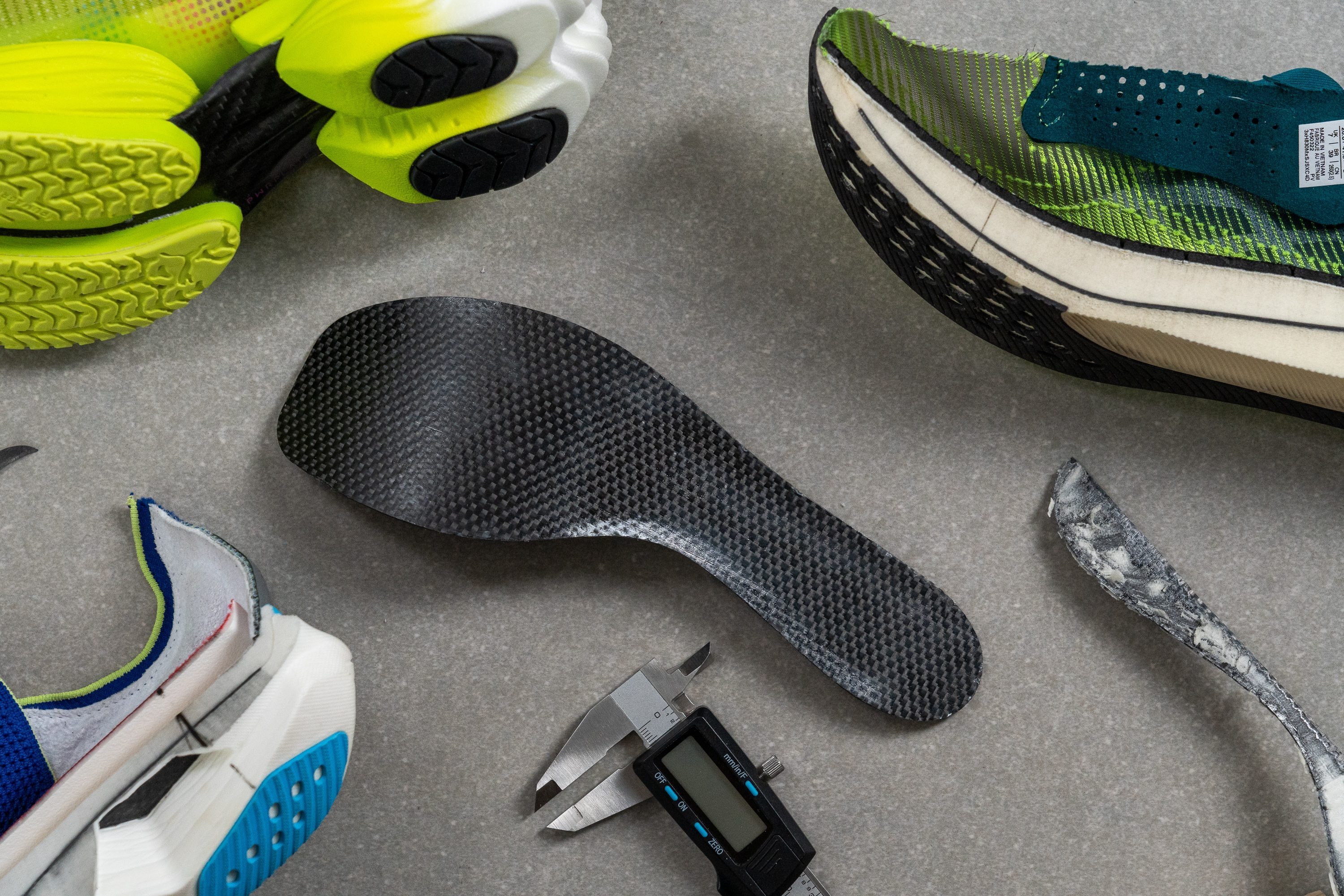
This guide covers what to expect from carbon plated shoes, how much they can improve running times and when they will not work. We’ve spent 20+ hours researching the topic and summarising scientific conclusions and our lab data.
Here, we don’t take sides in the “what did the carbon-plated shoes do to running” debate.
The majority of carbon-fibre plated shoes are race-ready. Given that these shoes were made and tuned for elite runners, they work best if you’re a competitive runner who is:
- Fit
- Most likely hitting the ground at the forefoot/midfoot. Carbon-plated running shoes for heel strikers are not the majority
- Fast (not a beginner, at least)
- Able to afford their premium price.
Examining the carbon plate on a shoe cut in half in our lab
[/local_video]
How fast can you be in carbon-fibre-plated running shoes
Runners wearing carbon-plated shoes managed to break every woman and man record from 5km to a marathon since the introduction of carbon-plated running shoes in 2016.
The most comprehensive studies have been conducted based on the Vaporflys. Nike’s claim that the shoes allow for the 4% improvement in the running economy was confirmed (here and here). Translated to running performance, this means 2-3% better finish times. Here are a few examples of how those improvements translate to finish times:
| Finish time | 2.5% improved finish time | |
| 5k | 00:34:37 | 00:33:34 |
| 10k | 01:02:08 | 01:00:16 |
| Half marathon | 02:14:59 | 02:10:56 |
| Marathon | 04:26:33 | 04:18:33 |
It’s worth noting that at higher running speeds, the improvement in running economy is higher than the improvement in speed. At slower speeds, the improvement in speed is a bit greater than the running economy improvement (as shown in this study).
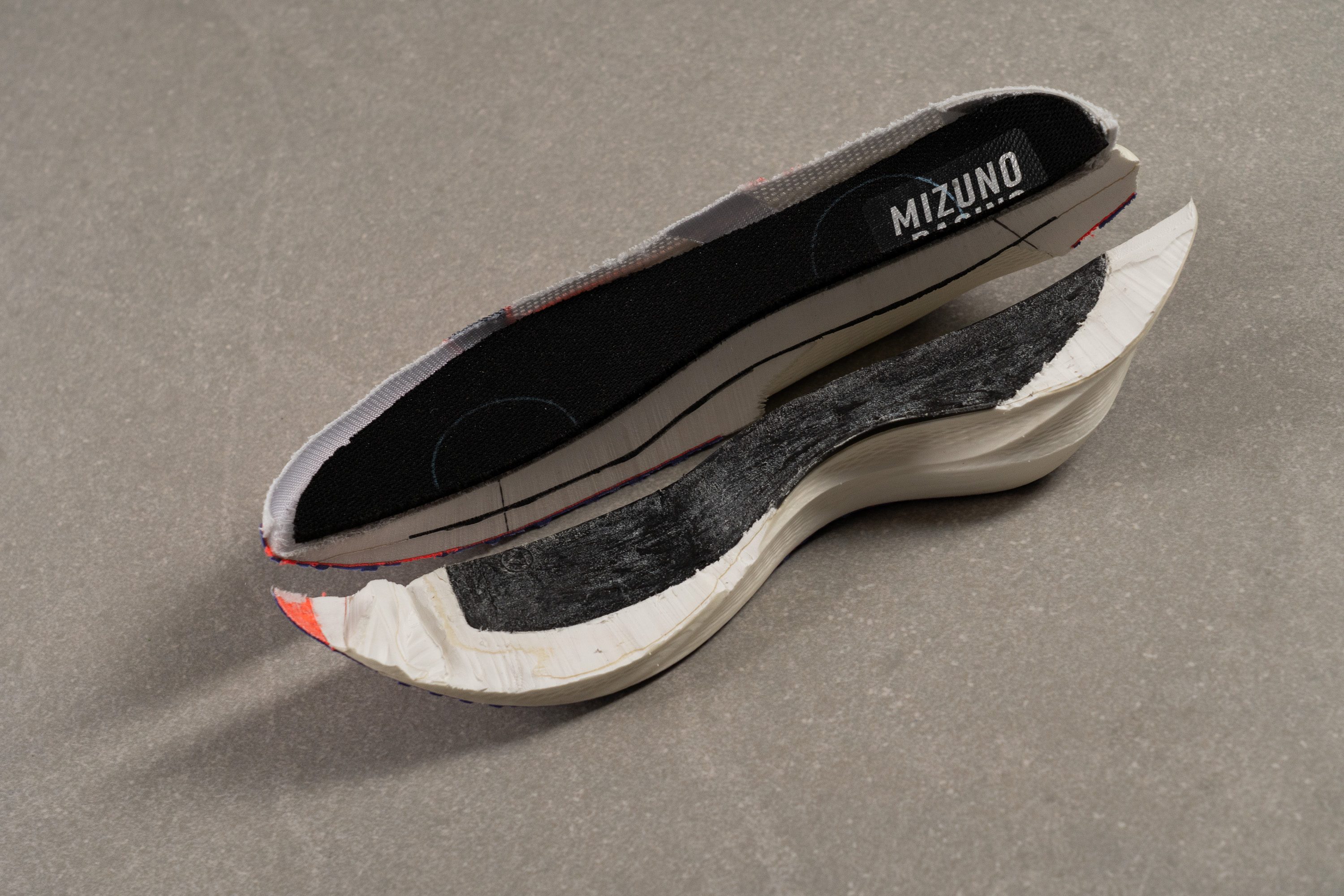
Example: at 5.5m/s (world-class marathon pace), it’s predicted that the improvement in velocity is â of the improvement in the running economy. For someone who’s doing a 2:04 marathon, and has a 3% running economy improvement, this means they will run the marathon 1.97% faster: 2:01:36.
Fun fact: back in 2019, Strava released a report claiming that the fastest runners wore Nike running shoes: Next% and Vaporfly.
Why are these improvements possible? Running in carbon-plated shoes allowed for metabolic savings due to:
- Superior energy storage in the foam
- Clever lever effects of the carbon plate on the ankle joint mechanics
- Stiffening effects of the plate on the metatarsophalangeal joint.
3 reasons carbon-plated shoes won’t work for you
Because they aren’t made for everyone.
1. Recommended runner’s weight for carbon-plated shoes
Heavy or too-skinny runners might not feel the expected benefits. Heavy runners tend to land on the heel and lightweight runners might not have enough weight to properly activate the plates. Professional athletes, whom most of the carbon-plated shoes are aimed at, are usually in the middle: fit.
2. Recommended pace for carbon-fibre plated shoes
Mind your pace.
Activating the plated shoe: fast-paced run + avoiding the heel strike:
[/local_video]
These shoes might be unstable at slower paces and, chances are, you won’t feel that special “pop” when just jogging. Pick up your pace.
Unstable heel in Nike Alphafly 3
[/local_video]
This study even suggested that Nike Vaporfly could be used for track racing, as well as road racing.
There are, however, some carbon-plated daily trainers. In that case, you are good even at slower speeds. It’s just a matter of affording an expensive daily trainer (for context, New Balance Lerato costs $230).

3. Recommended foot strike for carbon-plated shoes
Based on all the carbon-plated running shoes we've tested in our lab so far, we can say that 36% is good for forefoot/midfoot strikers, 48% for all strikes, and 16% for heel strikers only.
The design of carbon-plated shoes either dictates a forefoot-midfoot strike or leaves it “open for all”. When there are enforcements across the forefoot of the outsole, they suggest the shoes are made for forefoot/midfoot striking runners and they are there to ensure proper grip and durability.
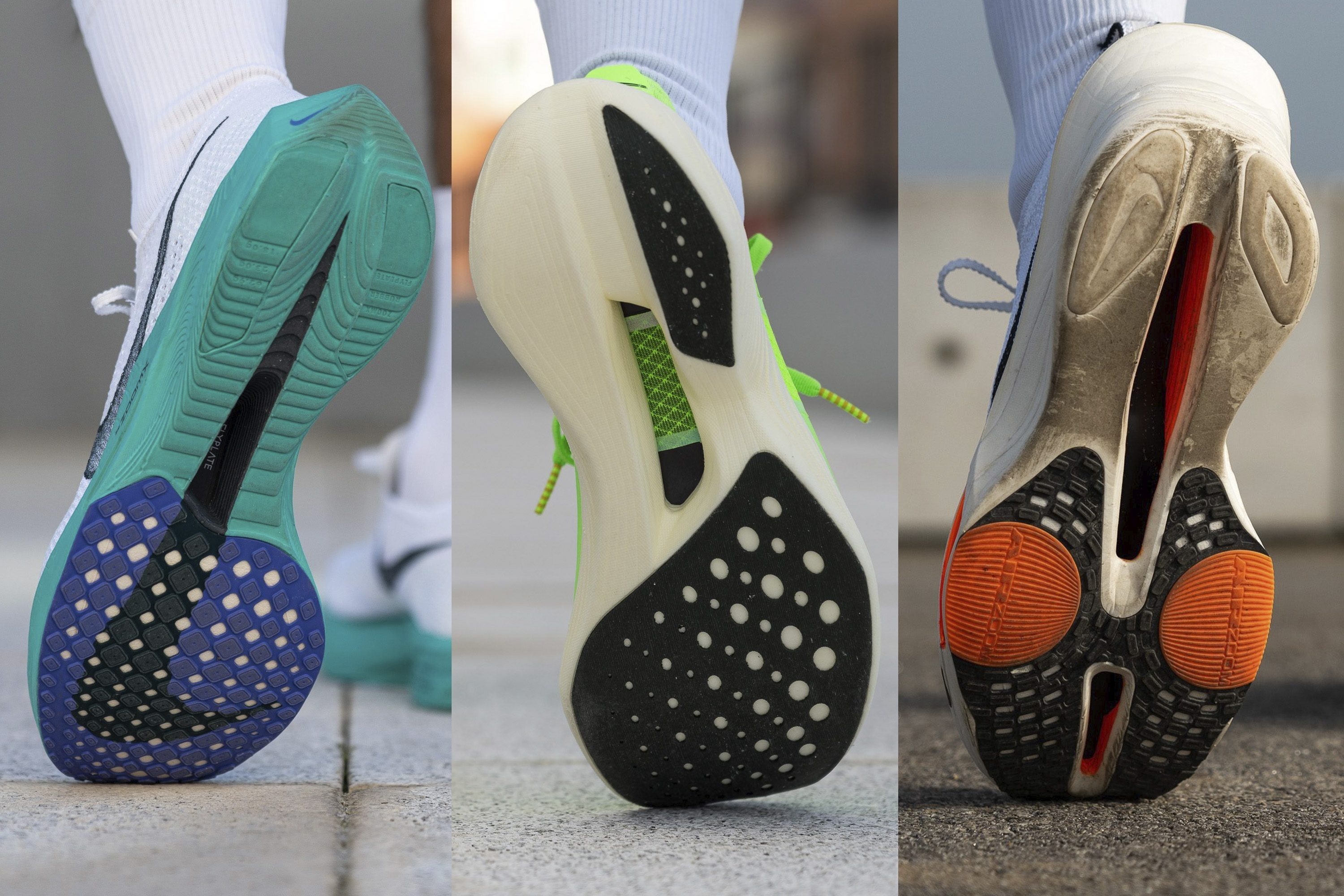
However, there are carbon-plated shoes whose outsoles are completely covered with rubber or have reinforcements at the heel area as well. This suggests they were made for heel strikers too. It’s always best to try them on and feel whether they actually propel you forward.
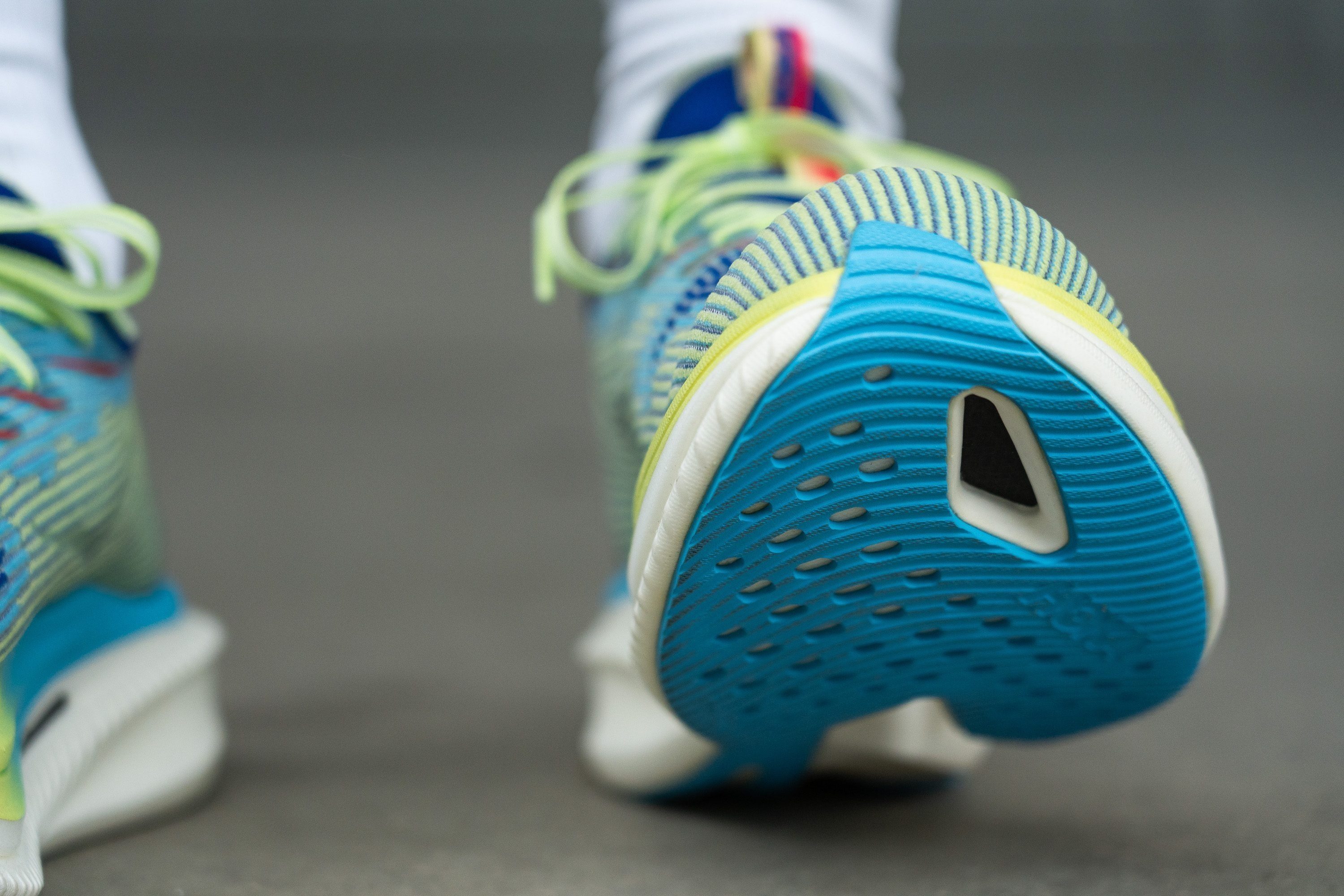
If you want to learn more about footstrike, read our Ultimate guide on foot strike.
How to choose THE BEST carbon-plated running shoe FOR YOU
Option A: Comfort.
If you have already answered the 3 requirements mentioned above, find the most comfortable carbon-plated shoe. We always say comfort is the key.
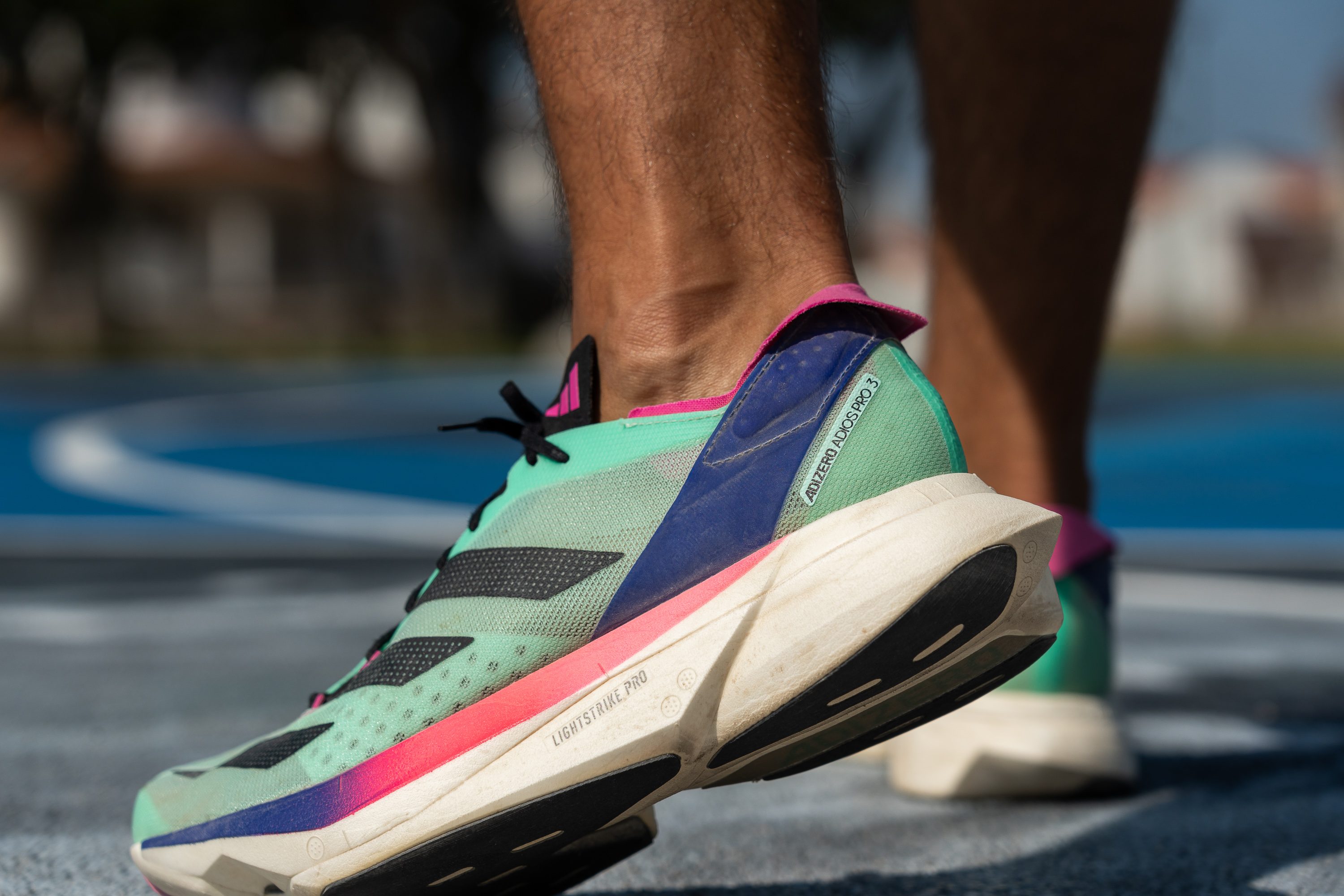
Option B: Lab test.
However, if you want to make every second of your run count, hit the lab. Other athletes have been doing it as well (look at the Tweet from Dan Nash, or read how Malindi Elmore used the lab data to choose the better shoe).
What this means is that you should find a physiology lab where you can perform running tests on a treadmill in different shoes and at different paces while a physiologist measures your oxygen consumption (you should be breathing through a mask).
[/local_video]
The personal approach proved highly valuable even in the case of Bekele since the original Vaporflys worked much better for Kipchoge than him.
This is the only way you can accurately measure which shoe will make you the fastest possible.
8 things that distinguish carbon-plated shoes from other running shoes

While it’s still not clear where the 4% improvements come from (is it the plate, the straighter toes, less work for the ankles, or the foam resilience…), we test and dissect the shoes and know what makes them different.
This is not a list of what to look for but rather what you should expect and be aware of when you decide to add a carbon-plated running shoe to your shoe rotation:
- Lightweight
- Soft
- Stiff
- Responsive
- High-stacked
- Unstable
- Not durable
- Expensive
We’ll cover all these features separately below.
Carbon-plated shoes are lightweight
The weight of the carbon-plated shoe came as a surprise at first, given their stack height, but quickly became a norm, given all the new technologies that are making the foams superlight.
The average weight of all road running shoes with a carbon-fibre plate we've tested so far in our lab sits at 8 oz or 228g, while the average for non-plated road shoes is 9.5 oz or 270.5g.

Plated midsoles are soft and stiff
Carbon-fibre plated shoes are softer and stiffer than other non-plated running shoes.
Without carbon-fibre plates, these shoes would just let your feet sink in and would not be responsive at all. Plates stiffen them up and make them pop. The fact that running in stiffer shoes might reduce muscle fatigue on long distances is a cherry on top.
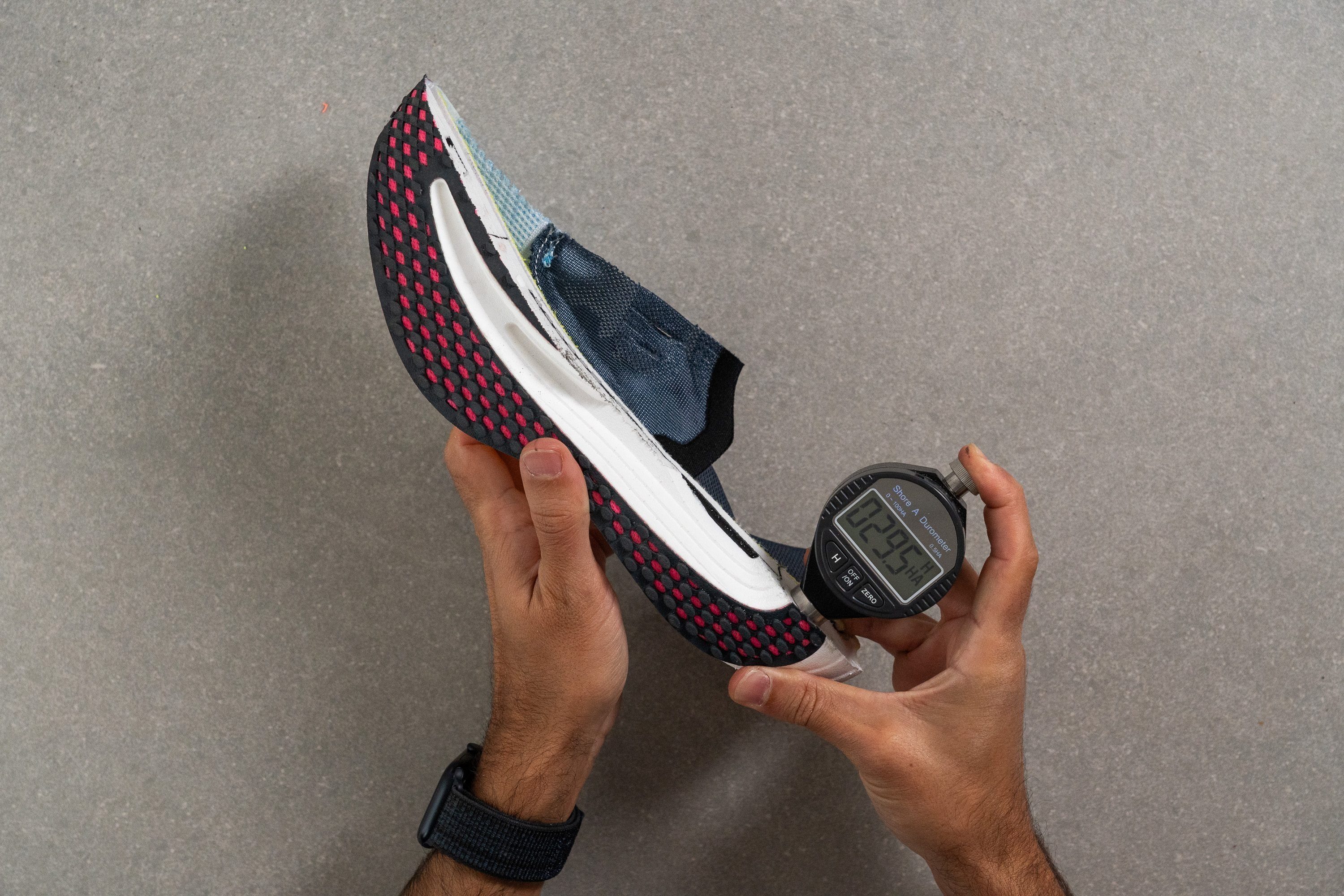
What makes them different is also being resilient: the foam returns most of the energy you use to squish it.
- Average midsole softness of running shoes with a carbon-fibre plate: 18.9 HA
- Average midsole softness of running shoes without a plate: 21.7 HA
If you’re unsure about the difference between midsole hardness and stiffness, look at our 2 guides: Guide: Soft vs. Firm Running Shoes and Guide: stiff vs. flexible running shoes.
When it comes to stiffness, we do 2 types of tests. To assess torsional rigidity, we twist them and assign a 1-5 rating, where 5 is the most rigid.
[/local_video]
When testing the stiffness, we lock the forefoot in place, adjust for the forefoot rocker, and then bend the shoe to 30 degrees. The lower the number on the display, the more flexible the shoe is!

This means we need less force to bend it, making the shoe more flexible.
| Flexibility of plated and non-plated road running shoes | ||
| Carbon-plated shoes | Non-plated shoes | |
| Avg. torsional rigidity | 4.5 | 3.1 |
| Avg. stiffness | 61.3N | 25.3N |
Stiffer shoes are better for sprint performance (source) and even for long distances, but it’s important not to go too stiff, as shown below.
Superb springiness: energy return lab test
Most common descriptors: Bouncy. Like a trampoline. Pushes you forward. Wants you to run, wants you to run fast. Propels you.
It’s how good these shoes are.
This extraordinary spring comes from a carbon-fibre plate that works in perfect tandem with a highly resilient (premium) foam:
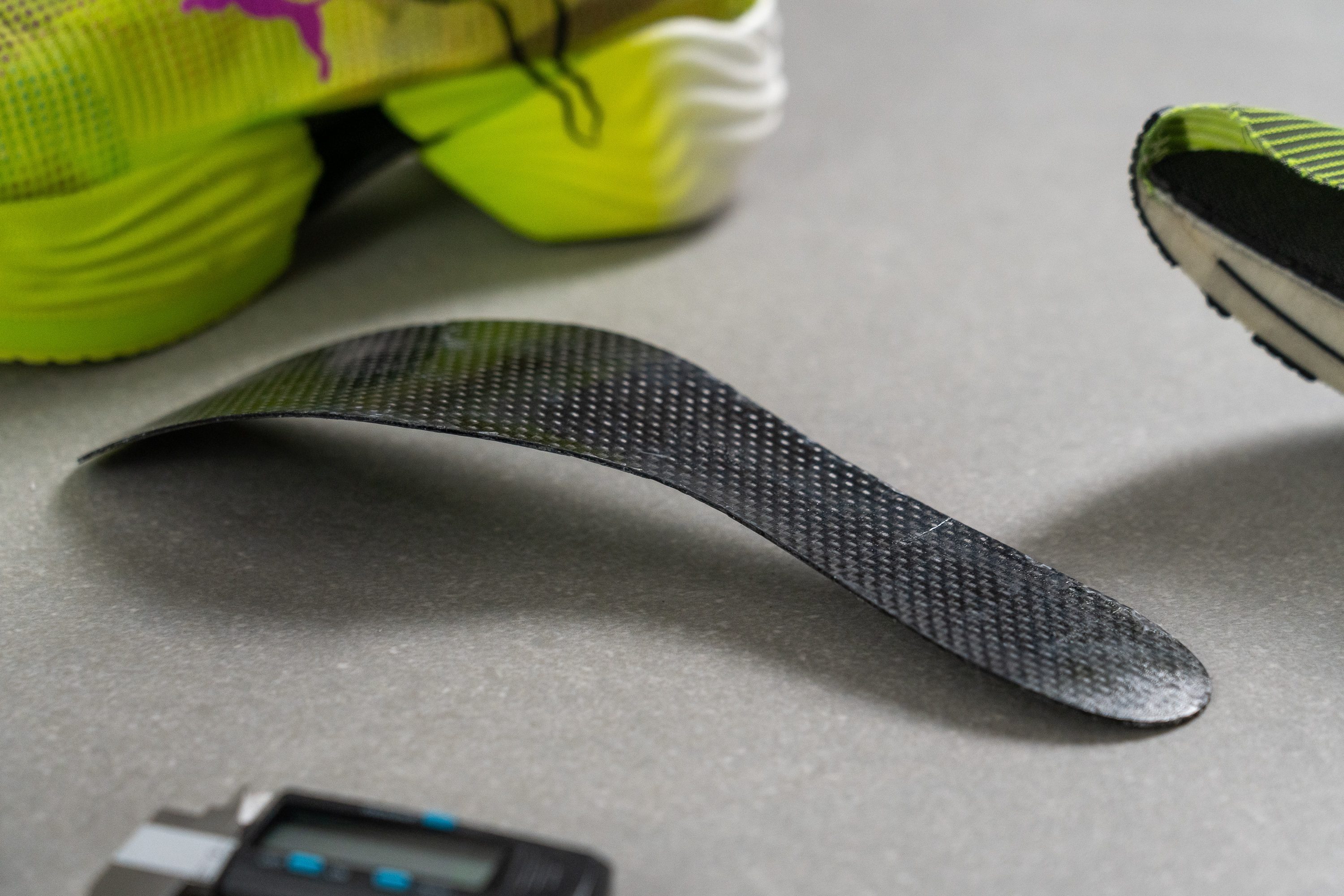
But, you don't have to check the type of foam or the shape of the carbon plate. In our lab, we measure the energy return (responsiveness) and publish the data.
Measuring the energy return of carbon-plated running shoes
[/local_video]
The higher the energy return, the better. It means that more energy is returned, making the ride more lively and responsive. Less of that energy is spent on heat and deformation.
Based on our lab tests so far, the average energy return of plated running shoes is 71.1%, while the average energy return of non-plated running shoes is 58.5%.
We test both energy return and shock absorption at the forefoot and at the heel. You can look up the numbers you need based on where you land (foot strike) while running.
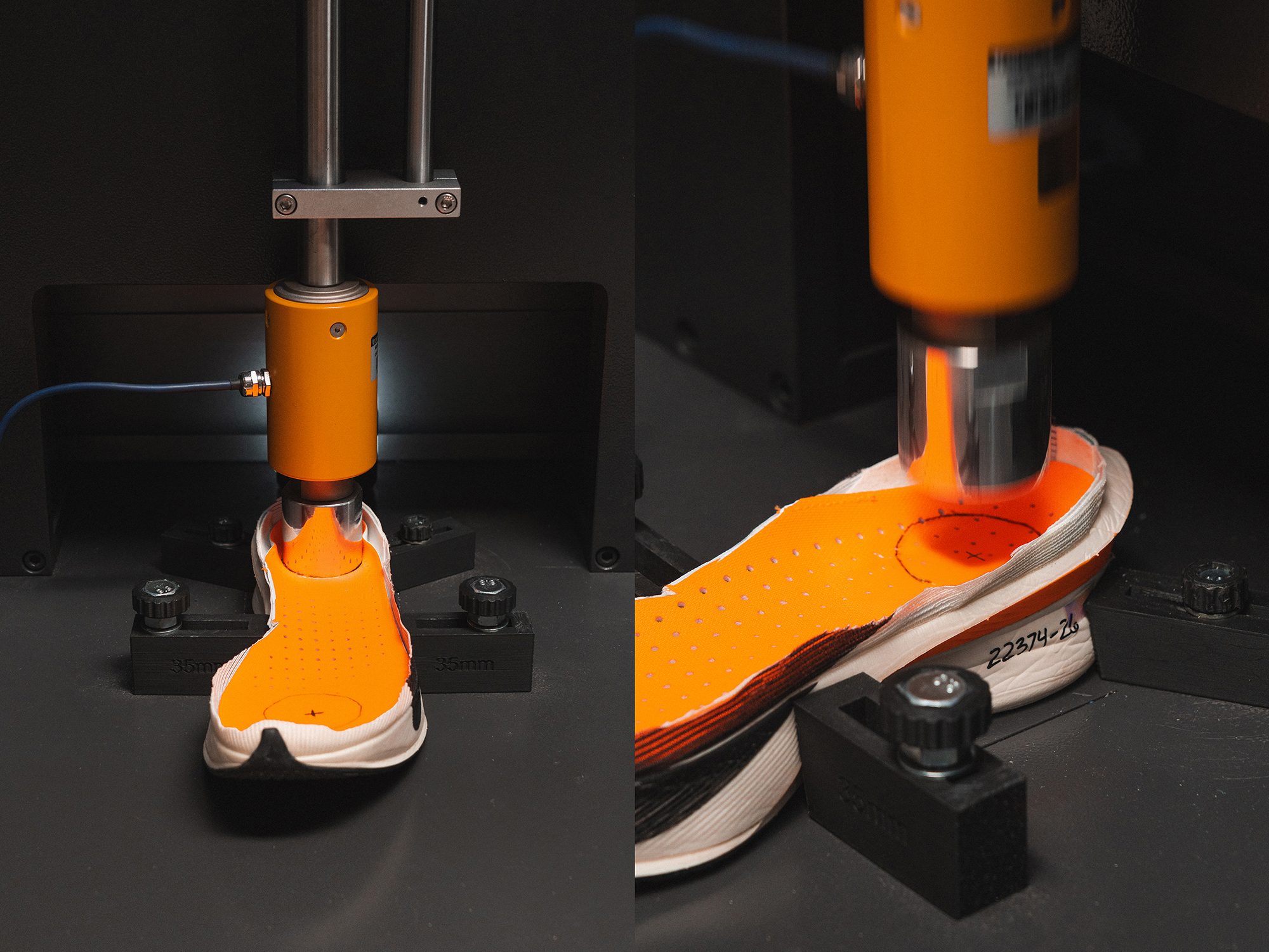
Rocker geometry in carbon-plated running shoes
When you have a thick slab of soft foam, you need something to make it stiffer. This is where carbon-fibre plates enter the scene. Now you need something to make this midsole roll better. And, it's where the rocker gets the spotlight!
[/local_video]
| If you're not familiar with what rockers are and how they work, we recommend diving deep together with us: All you need to know about rockered running shoes. |

Why you may not want to run if rockered running shoes? Well, these shoes are not the best choice for runner's knee or hip injuries (labral tear of the hip, hip bursitis, flexor strain, ITBS, patellofemoral pain syndrome, meniscus tears, jumper's knee, etc.).
Below, we can see different designs of forefoot and heel rockers.
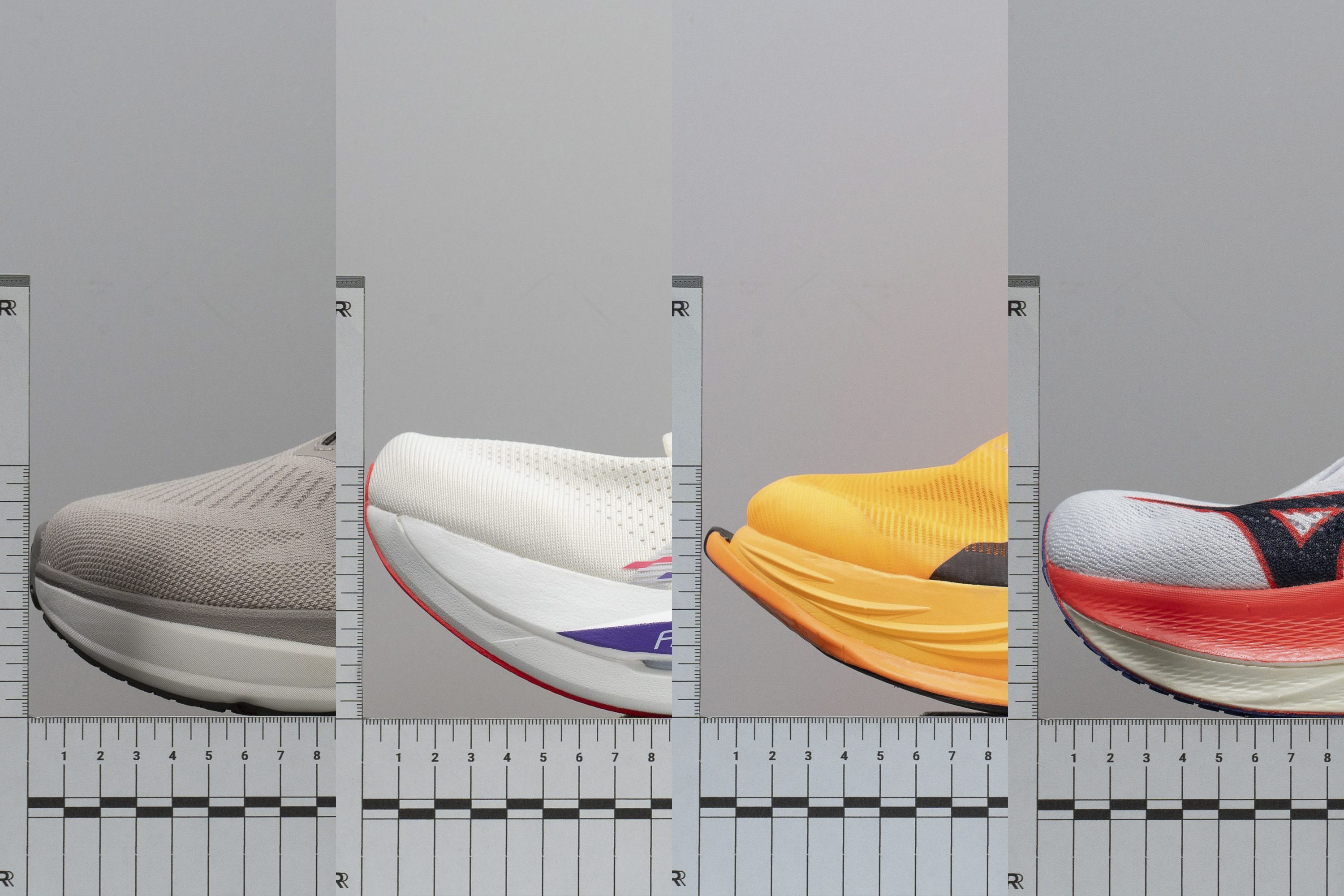
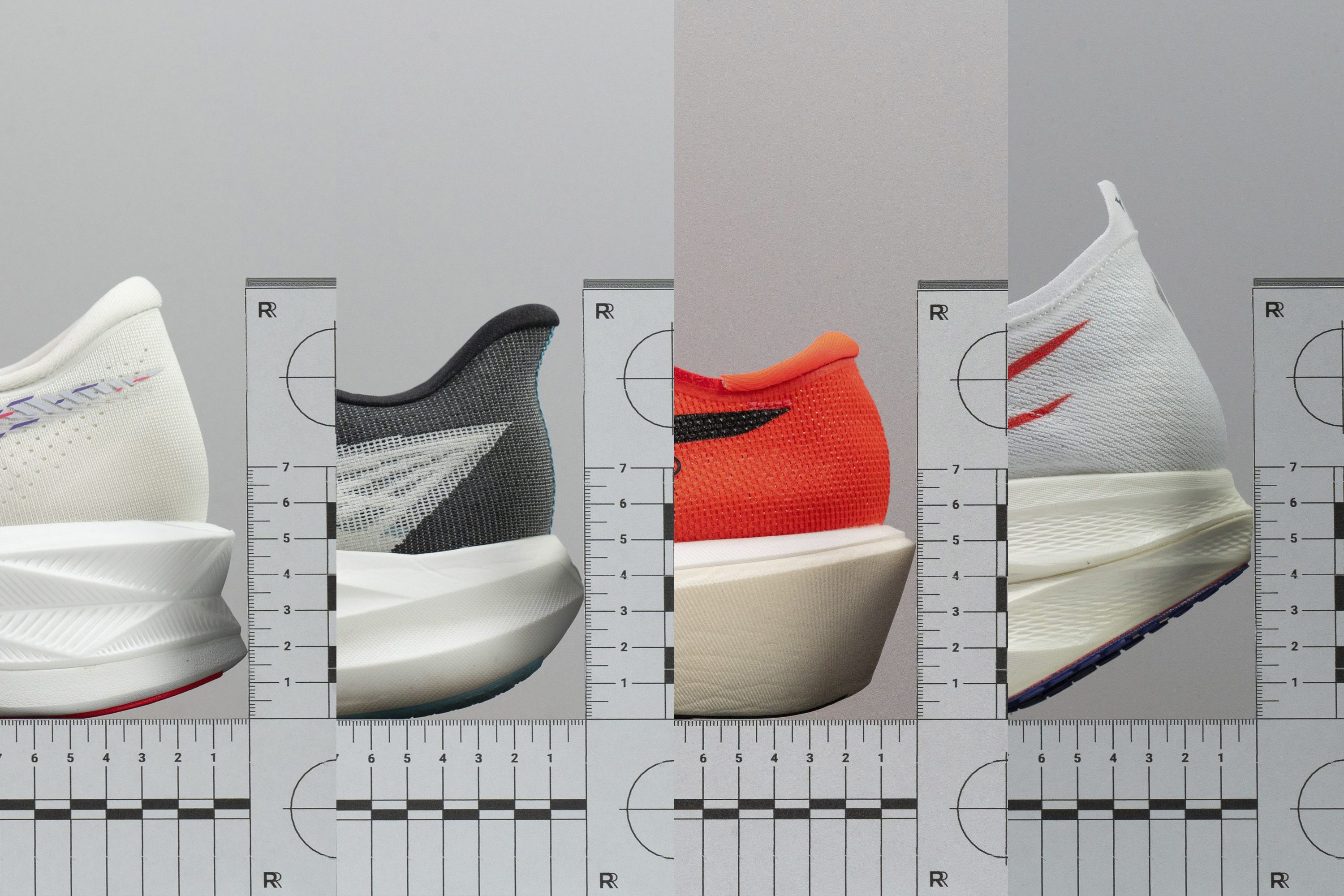
Premium price of carbon-plated running shoes
These come at a steep price:
- Average price of road running shoes with a carbon-fibre plate: $217.2
- Average price of road running shoes with no plate: $129.5
On average, carbon-plated running shoes are 40.4% more expensive than non-plated running shoes.
High off the ground in carbon-plated shoes
So high that World Athletics had to come up with regulation and limit the height of the shoes to 40mm. Anything above and you’re disqualified in road running events. Pushing all the boundaries is, for example, Adidas Adizero Prime X at 50mm in the heel.
[/local_video]
For context, look at these numbers on stack heights between shoes with and without a carbon-fibre plate:
| Plated shoes | Non-plated shoes | |
| Avg. forefoot height | 28.4 mm | 23.8 mm |
| Avg. heel height | 36.2 mm | 33.1 mm |
Here’s how we measure heel and forefoot stack height in our lab: at 12% and 75% of the internal length of the shoe on the centerline.
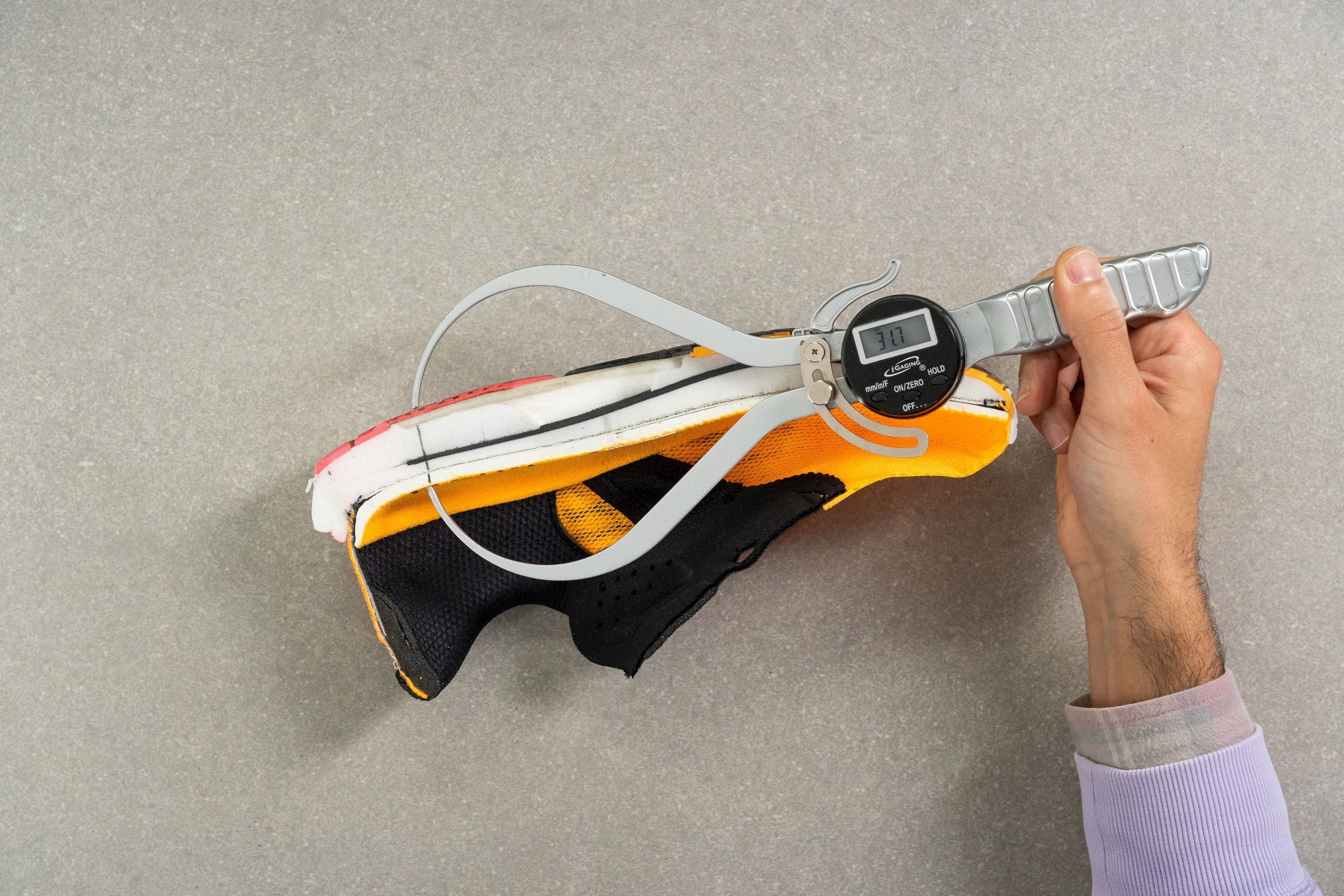
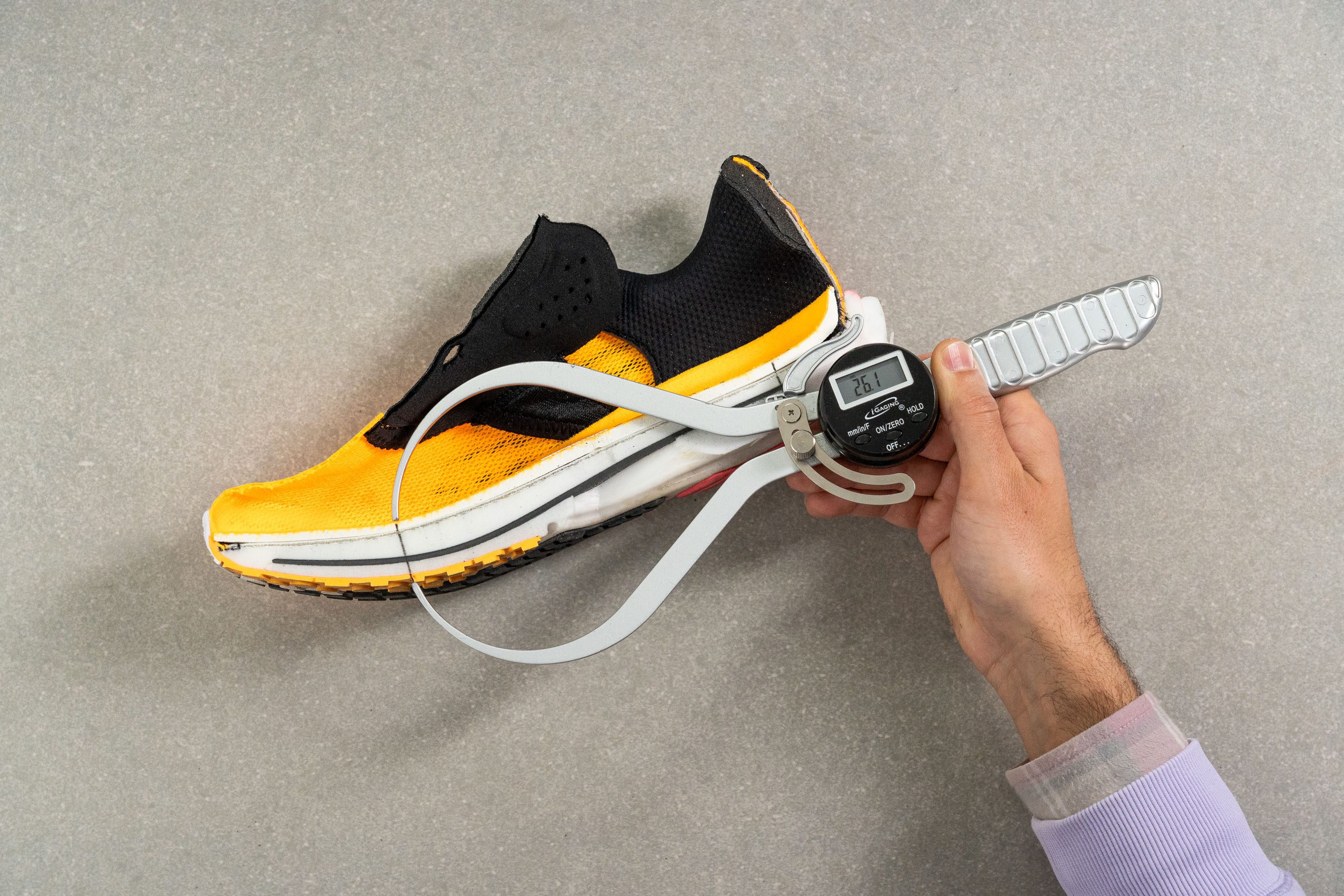
Unstable for walking, sharp turns and uneven terrain
As mentioned above, due to their high stacks, narrow platforms soft foams, and race profile, carbon-plated shoes are usually really unstable. Especially at the rearfoot area.
Heel instability noticeable on the sharp turn in the Alphafly 3
[/local_video]
That’s why they ask for some adaptation period and are not recommended for trails (unless we’re talking about carbon-plated trail shoes). Best for running fast and running straight ahead.
How narrow are these shoes at the base? Let's compare them to the non-plated shoes:
| Carbon-fibre plate | Shoes with no plate | |
| Avg. midsole forefoot width | 111 mm | 114 mm |
| Avg. midsole heel width | 84.9 mm | 91.1 mm |
At the heel, they are 6.2 mm narrower on average!
Here’s what that instability looks like in the ASICS Metaspeed Ray:
[/local_video]
How durable are carbon-plated running shoes?
They started as race shoes. Even though we can find some plated daily trainers, when it comes to plated competition running shoes, they should be saved for race days given their lack of durability. They usually lack thicker rubber at the bottom or have too much of the midsole exposed.
In our lab, we test the durability of running shoes in 3 places: toebox, heel padding, and outsole. We press our Dremel against the material and assess or measure the damage we've made.
Testing the durability of Adidas Adizero Adios Pro 3 using a Dremel in RunRepeat lab
[/local_video]
The bigger the damage, the less durable the material. We always apply the same pressure and RPMs, so all these results are comparable between shoes.

Testing the durability of the heel padding in carbon-plated shoes
[/local_video]
The only thing that is different when it comes to testing the outsole's durability is our use of a tyre tread gauge. With it, we're able to measure the exact depth of the hole our Dremel has made and to correlate that with the durability. Bigger dent = less durable outsole.

This number should be taken with a grain of salt because we measure the outsole durability at the heel and, as explained above, carbon-plated running shoes are usually best utilised by forefoot-to-mid strikers.
Design of the carbon plate
Carbon-fibre plates can be full-length or partial. The length of the plate plays a big role in how the shoe performs, together with the foam, and there are different types of foam.

The longer the plate, the higher the rating for torsional rigidity. Obviously. With shorter plates, this might mean less pop during the ride, as well as less stability. Trail shoes usually have non-full-length plates like the one in the example above (shoe in the middle) as brands tend to use forked carbon-fibre plates in trail running shoes.
Researchers (Song et al., 2023) looked at the position of the plate and found that thicker carbon-fibre plates that are placed closer to the outsole reduced the forefoot pressure and strain the most. Carbon-fibre plates that were placed just under the insole increased the stress on the metatarsal bones!
Looking at the curvature, both curved and flat carbon plates were found (Song et al., 2024) to make the impact (force) transmission more uniform, but curved plates reduced the forefoot pressure more than the flat ones. They also improved how forces were distributed across the metatarsals without increasing bone stress. These results suggest that curved plates may offer better injury protection.


For the most comprehensive overview of foams in running shoes, read our insanely detailed guide on foams.
Carbon-plated shoes for trail
First, we had carbon-plated road shoes. Then, carbon-plated trail shoes entered the scene. These shoes offer a snappy ride and are great for the long haul (some, even for 100-mile races).
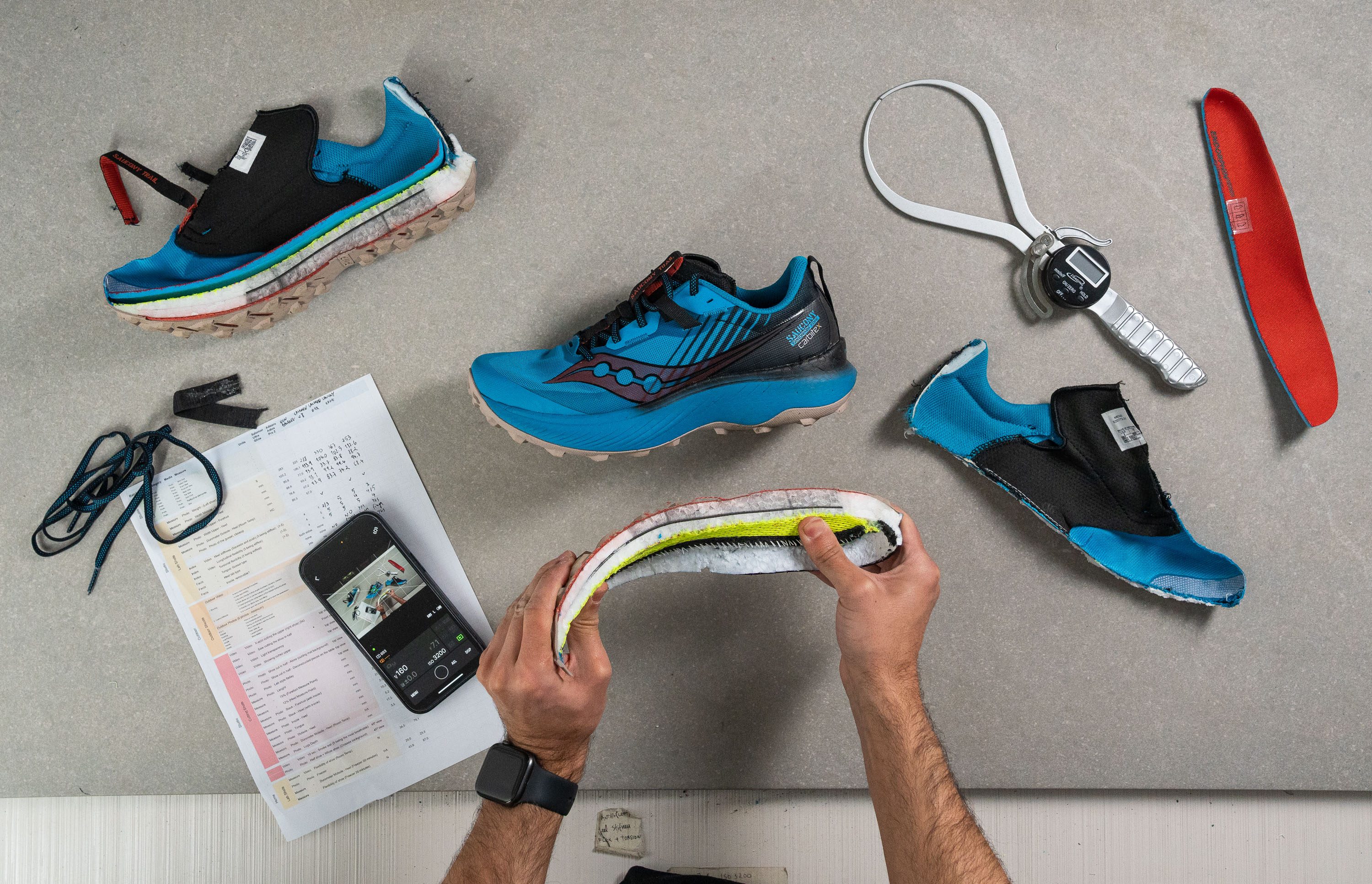
The main difference when it comes to our lab testing? Here, we also measure the thickness of the lugs.

And, when doing the outsole durability test, we damage the lugs.

Latest studies on carbon-plated running shoes
Throughout this article, we've already mentioned numerous studies. However, given that carbon-plated running shoes are still a big deal and an important topic, new studies keep popping up. Here are the freshest ones:
- Technologically advanced running shoes (TARS) or running shoes with carbon-fibre plates were compared to conventional cushioned running shoes and to minimalist running shoes. The study has shown that plated shoes reduced ankle loading and lowered forces in foot and calf muscles without adding extra load elsewhere. This suggests that running shoes with a carbon plate may offer safer and more efficient biomechanics. Kim et al., 2025
- Thanks to a more propulsive push-off, running shoes with carbon-fibre plates create a more efficient toe-off. Spencer et al., 2025
- Curved carbon-fibre plates can reduce the mechanical load on the him and knee joints, unlike the flat plates. Xu et al., 2025
- Running shoes with carbon-fibre plates may boost performance while reducing the injury risk. This is accomplished by reducing the load on the knee and changing how the leg muscles work at faster speeds. Yang et al., 2025
- Carbon-fibre insoles were shown to bring no performance gains to the table when compared to the plates embedded in the midsoles. However, runners felt more explosive while using them. Dierickx et al., 2023
- Running in a plated vs non-plated running shoe on flat terrain, uphills, and downhills has shown that the plated shoe is better because it reduced metabolic cost by 3.8% on flat ground, 2.8% uphill, and 2.7% downhill. Whiting et al., 2022
